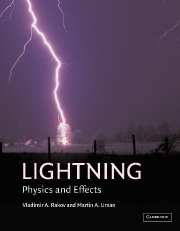Book contents
- Frontmatter
- Contents
- Preface
- 1 Introduction
- 2 Incidence of lightning
- 3 Electrical structure of lightning-producing clouds
- 4 Downward negative lightning discharges to ground
- 5 Positive and bipolar lightning discharges to ground
- 6 Upward lightning initiated by ground-based objects
- 7 Artificial initiation (triggering) of lightning by ground-based activity
- 8 Winter lightning in Japan
- 9 Cloud discharges
- 10 Lightning and airborne vehicles
- 11 Thunder
- 12 Modeling of lightning processes
- 13 The distant lightning electromagnetic environment: atmospherics, Schumann resonances, and whistlers
- 14 Lightning effects in the middle and upper atmosphere
- 15 Lightning effects on the chemistry of the atmosphere
- 16 Extraterrestrial lightning
- 17 Lightning locating systems
- 18 Deleterious effects of lightning and protective techniques
- 19 Lightning hazards to humans and animals
- 20 Ball lightning, bead lightning, and other unusual discharges
- Appendix: Books on lightning and related subjects
- Index
16 - Extraterrestrial lightning
Published online by Cambridge University Press: 05 June 2013
- Frontmatter
- Contents
- Preface
- 1 Introduction
- 2 Incidence of lightning
- 3 Electrical structure of lightning-producing clouds
- 4 Downward negative lightning discharges to ground
- 5 Positive and bipolar lightning discharges to ground
- 6 Upward lightning initiated by ground-based objects
- 7 Artificial initiation (triggering) of lightning by ground-based activity
- 8 Winter lightning in Japan
- 9 Cloud discharges
- 10 Lightning and airborne vehicles
- 11 Thunder
- 12 Modeling of lightning processes
- 13 The distant lightning electromagnetic environment: atmospherics, Schumann resonances, and whistlers
- 14 Lightning effects in the middle and upper atmosphere
- 15 Lightning effects on the chemistry of the atmosphere
- 16 Extraterrestrial lightning
- 17 Lightning locating systems
- 18 Deleterious effects of lightning and protective techniques
- 19 Lightning hazards to humans and animals
- 20 Ball lightning, bead lightning, and other unusual discharges
- Appendix: Books on lightning and related subjects
- Index
Summary
In terrestrial lightning the cloud-to-ground discharges are the most intensively studied, and this is a type of lightning that is not expected to occur in other planetary atmospheres.
K. Rinnert (1995)Introduction
Most lightning discharges on Earth are produced by convective, precipitating clouds that contain water in both liquid and solid phases (Section 3.2). Apparently, convective clouds whose tops are below the freezing level, so that they do not contain ice, can also sometimes produce lightning (e.g., Foster 1950; Moore et al. 1960; Pietrowski 1960; Michnowski 1963; Rossby 1966). On Earth, lightning-like electrical sparks hundreds of meters long can be produced via charge generation and separation in volcano emissions, and sparks of meter length can occur in sandstorms (subsection 20.7.1). Further, electrical sparks having a length of the order of one meter or less occur in a variety of non-meteorological turbulent particulate media, such as in the material in grain elevators and in the mixture of water and oil present during the water-jet cleaning of oil tanker holds (Pierce 1974). Finally, transient luminous phenomena that may be associated with electrical discharges have been observed during earthquakes (subsection 20.7.2).
Based on the observed conditions for the production of lightning on Earth, the two requirements for the generation of lightning or lightning-like electrical sparks in the extraterrestrial environment are: (i) the interaction of particles of different types or of the same type but with different properties (for example, different temperatures), resulting in local charging,
- Type
- Chapter
- Information
- LightningPhysics and Effects, pp. 528 - 554Publisher: Cambridge University PressPrint publication year: 2003



